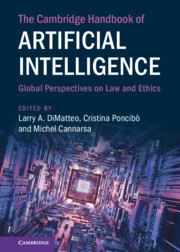Book contents
- The Cambridge Handbook of Artificial Intelligence
- The Cambridge Handbook of Artificial Intelligence
- Copyright page
- Contents
- Figures
- Contributors
- Foreword
- Preface
- Part I AI: Development and Trends
- Part II AI: Contracting and Corporate Law
- Part III AI and Liability
- 7 Are Existing Tort Theories Ready for AI?
- 8 Are Existing Tort Theories Ready for AI?
- 9 Liability for AI Decision-Making
- 10 AI and Data Protection
- 11 AI as Agents
- Part IV AI and Physical Manifestations
- Part V AI and Intellectual Property Law
- Part VI Ethical Framework for AI
- Part VII Future of AI
9 - Liability for AI Decision-Making
from Part III - AI and Liability
Published online by Cambridge University Press: 28 July 2022
- The Cambridge Handbook of Artificial Intelligence
- The Cambridge Handbook of Artificial Intelligence
- Copyright page
- Contents
- Figures
- Contributors
- Foreword
- Preface
- Part I AI: Development and Trends
- Part II AI: Contracting and Corporate Law
- Part III AI and Liability
- 7 Are Existing Tort Theories Ready for AI?
- 8 Are Existing Tort Theories Ready for AI?
- 9 Liability for AI Decision-Making
- 10 AI and Data Protection
- 11 AI as Agents
- Part IV AI and Physical Manifestations
- Part V AI and Intellectual Property Law
- Part VI Ethical Framework for AI
- Part VII Future of AI
Summary
Since the second AI revolution started around 2009, society has witnessed new and steadily more impressive applications of AI. The growth of practical applications has in turn led to a growing body of literature devoted to the liability issues of AI. The present text is an attempt to assess the current state of the law and to advance the discussion.
- Type
- Chapter
- Information
- The Cambridge Handbook of Artificial IntelligenceGlobal Perspectives on Law and Ethics, pp. 116 - 131Publisher: Cambridge University PressPrint publication year: 2022

